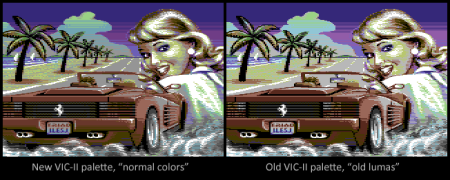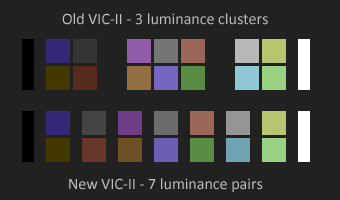Early VIC-II chips produced somewhat different colors than the later ones. In the earliest revisions the 16 colors had five luminance levels, i.e. brightness values. Black and white are the lowest and highest values, and the remaining 14 colors use three luminance levels that are evenly spaced in the brightness spectrum. Simply put, there are dark grey, medium grey and light grey, and all the colors are as bright or dark as these three shades of grey.
In later VIC-II revisions four intermediate luminance levels were introduced. Now there was nine luminance levels instead of the previous five. The palette with nine luminance levels is what most people consider as the normal C64 colors. From this article you can read all about C64 luminance levels and colors.
In this picture you can see how the different luminances affect picture that has been made for the “normal” C64 colors:

Notice how the face has become ‘flat’ as some of the shading has been lost. There is also a dramatic difference in the shadows under the palm trees.
Generally having more luminance levels is a good thing. It gives better possibilities for making smooth color gradients for example. More steps from light to dark, that is. And quite frankly, pictures made with the normal C64 colors can look quite bad if viewed with old colors. Of course this works both ways. Much like it is with SID music made for either new or old SID chip. However, these considerations and personal preferences aside, there’s at least one benefit with the fewer brightness levels of the old luma colors.
But first let’s talk about the color encoding and color bleeding.
Firstly, the C64 does not process the picture in RGB format. Instead, the C64 video chip generates the video signal as luminance (brightness) and chrominance (color) components. The luma and chroma signals can be carried to the monitor as such or in form of S-Video, or as combined into composite video, or even worse, as RF modulated antenna signal. In any of the cases, the color information needs to be decoded in the TV or monitor into RGB signal for the display.
The way how the color information encoding and decoding work in the PAL standard has the following effect, quote:
colors with the same luminance mix perfectly when drawing them in alternating lines
In other words, colors blend into each other vertically. And the luma-matching blended colors appear as solid colors – they don’t look striped at all. This is a well-known trick among the C64 artists who know their stuff. It’s a clever way to create colors that do not actually exist in the C64 palette. For example, alternating brown and blue lines will create a slightly darker shade of grey than the actual dark grey (with normal C64 colors).
In addition to that, quote
additionally, since the VIC (or the circuits in the C64) can/do not encode the color signal with a perfect phase offset of 180 degrees every other line, these mixed colors turn out differently depending on which colors are in odd/even scanlines
This means you can create two slightly different mix colors from two ‘base’ colors depending on which order you use them.
And here’s the fun part: Making use of the color blending with old lumas actually can create more colors than with new lumas, as there are more luminance-matching colors to mix!
With new lumas, the colors are divided into luminance pairs – only two colors share the same luminance in the entire palette. Seven color pairs can create 28 different colors including the normal ‘base’ colors. Add black and white and you have 30 theoretical colors with the new VIC-II.
With old VIC-II the calculation looks different. There are four dark colors, six medium colors, and again four bright colors. Counting all the different blending possibilities you’ll get 16 + 36 + 16 colors plus black and white. That makes 70 theoretical colors!
Unfortunately that sounds better than things are in practice. For example many of the mix colors are nearly identical and thus not very practical. And the resulting “palette” is not the most pleasant to the eye. One could call it “50 shades of brown”.
Still, there are far more mix-color choices than with new VIC-II, and the resulting colors are distinctive as those differ from the “normal” colors everyone has grown so familiar to.
Of course the color blending effect does not work with emulators unless there’s an option for PAL encoding or monitor emulation. With any real PAL C64 the effect is visible, no matter what kind of TV or monitor you are using. The blending happens within the video signal encoding and decoding process, so it works on modern flat panel just like it does on a CRT TV. Contrary to PAL machines, the vertical color blending does not work on NTSC systems, since the NTSC color encoding works in a different way.
With these theoretical possibilities in mind, I set myself to make a picture that makes use of old VIC colors and color blending. That’ll be part 2 of this topic!
Here’s two very relevant studies on C64 color and picture reproduction which I’ve referred in my article:


